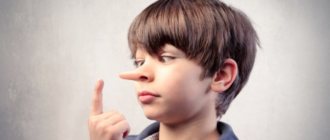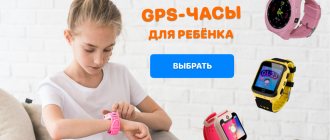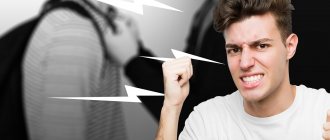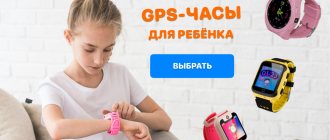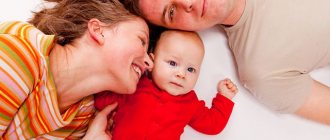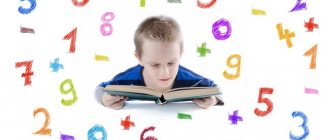You entered a store and saw a mother with a child running between the shelves and knocking over bags of groceries. What do you think at this moment - is this a hyperactive child or are his parents raising him poorly?
- How to figure out whether a child is behaving badly because he has “lost his hands” or he still needs to be shown to specialists.
- The doctor wrote "ADHD" on your child's chart. Is this a terrible diagnosis, do I need treatment or look for a good tutor?
- The child is uncontrollable, the mother-in-law says that the child’s father was also very active in childhood, but then “outgrew it.” Should I wait until he “outgrows it”, or is it better to take him to see a psychologist, as a friend advises?
- The child behaves badly, loses everything and forgets, punishments do not work. What to do?
It makes sense to install the “Where are my kids” application in order to exercise parental control over a hyperactive child without intruding too much into his boundaries.
You will find the answer to these and other questions in this article.
Content
- ADD and hyperactivity: what is it Types of hyperactivity
- Biological factors
- Hyperactivity
- ADHD or not?
ADHD: what is it?
ADHD stands for Attention Deficit Hyperactivity Disorder. It is characterized by increased motor activity and problems with attention and perseverance. More than half of the cases are accompanied by behavioral disorders and emotional instability (according to the Serbsky Medical Research Center for Psychiatry and Narcology).
ADHD is not just a diagnosis, but a whole group of disorders that are combined based on the presence of signs that do not correspond to age. Hyperactivity, attention deficit, impulsiveness, lack of sustainable motivation for activities that require volitional efforts - all this is ADHD.
Children with such disorders adapt poorly to society:
- “bad” behavior in kindergarten;
- conflicts with peers on playgrounds;
- problems with school performance;
- Difficulties with behavior in class (try to sit still, arms folded, for a whole 40 minutes, when there is so much interesting outside the window, and there is a cloud of thoughts in your head, and everything is not about studying);
- reluctance and inability to do homework independently, etc.
Types of hyperactivity
ADHD does not affect everyone the same way. When diagnosing, several types of syndrome are distinguished. Children may experience both excessive mobility and attention disorder, or there may be attention deficit without a hyperactive component. Or vice versa - the child is very impulsive, with difficult behavior that he cannot control, but he manages to perform attention tasks well. There are also mixed types. In any case, in order to accurately diagnose the disorder, studies (MRI, EEG, etc.) and medical supervision are necessary.
When it appears
It is believed that hyperdynamic activity syndrome manifests itself most clearly in preschool (4-5 years) and primary school age (6-8 years). The child ends up in a children's group and cannot withstand the modern pace of learning.
All the signs of his hyperactivity immediately appear: the teacher or educator cannot cope with the child, he does not master the curriculum and other problems of his behavioral disorders.
However, the first signs of hyperdynamic syndrome can be detected in infancy. Such babies are very active and emotional: they get unstuck from their diapers, fall, if you just turn away for a moment, they sleep poorly, their sleep is superficial, restless, and they can scream all night for no reason.
As they grow older, the behavior of hyperactive children continues to “delight” their parents: they get out of playpens and strollers, often fall, get into everything, and knock over everything.
Babies are already 1-2 years old and active and overly mobile; mothers can barely keep up with them. They are not interested in games where you need to think, add, build. It is difficult for a hyperactive child to finish listening to a fairy tale or watching a cartoon; he cannot sit still.
What should parents do if they suspect their child has hyperactivity disorder?
Scale of the problem
How many children like this are there in the world?
According to epidemiological studies in different countries, the incidence of this disorder ranges from 1-3% to 24-28%.
By age, this is approximately 5% among children under 18 years of age, 6% among school-age children, 3% among adolescents.
According to statistics, the leaders in the number of children with ADHD are the USA (4 - 20%) and Russia (7 - 16%). Then come China (1 – 13%) and Italy (3 – 10%).
*Data from “Hyperkinetic disorders” (ADHD) Koren E.V., Kupriyatnova T.A – Federal Medical Research Center for Psychiatry and Narcology named after V.P. Serbian Ministry of Health of Russia, Moscow, 2015.
The dispersion in statistics is due to the fact that different countries have different criteria and diagnostic methods.
Positive qualities of hyperactive children
Despite all the unpleasant behavioral characteristics of children with hyperdynamic syndrome, they also have many positive qualities, the development of which parents should pay special attention to.
- A hyperactive child has creative, creative thinking.
He can come up with a lot of interesting ideas, and if you have enough patience, he can be creative. Such a child is easily distracted, but has a unique view of the world around him.
- Hyperactive children are usually enthusiastic. They are never boring.
They are interested in many things and are, as a rule, bright personalities.
- Such children are energetic and active, but often unpredictable.
If they have a motive, then they do everything faster than ordinary children.
- A child with ADHD is very flexible, resourceful, and can find a way out where others would not notice, and solve a problem in an unusual way.
The intelligence of children with ADHD is not impaired in any way. Very often they have high artistic and intellectual abilities.
Specific ways to communicate and interact with such children are given in the following video:
Causes of ADHD
The causes of ADHD have not yet been established. Everyone who deals with this problem recognizes the multifactorial nature of their occurrence.
There are 3 main groups of factors that influence the appearance of hyperactivity in children:
Biological factors
These are cerebral-organic factors, i.e., damage to the nervous system. Risk factors include:
- fetal hypoxia during pregnancy and childbirth;
- disturbances during pregnancy and childbirth;
- prematurity and postmaturity;
- intrauterine hypotrophy;
- pregnancy before 20 years and after 40;
- maternal use of alcohol, medications during pregnancy, smoking.
Genetic factors
The heredity of ADHD is confirmed in 50% of people with this syndrome.
Psychosocial factors
- Low social status of the family
- Alcoholism of parents
- Severe disagreements between parents
Environmental factors (they rather aggravate the condition, but are not decisive)
Ecology and nutritional balance also affect the general health of children and the development of their nervous system.
Children at risk for ADHD are those who:
- lack of protein in the diet;
- excess of easily digestible carbohydrates, especially in the morning;
- deficiency of vitamins and microelements (for example, according to studies, 70% of hyperactive children had a deficiency of magnesium).
Causes of hyperactivity in children
Increased excitability is usually observed in children whose parents have a choleric character. Children, as a rule, only copy behavior in a more pronounced form.
If we consider the signs of hyperactivity in a child under one year old, there is a clear tendency towards a genetic predisposition for the transmission of this pathology. Approximately 45% of parents of hyperactive children suffered from this condition in childhood.
In most cases, disruptions in brain activity begin in utero. The following factors can lead to the formation of pathology:
- Difficult pregnancy;
- Unhealthy lifestyle or maternal smoking while expecting a baby;
- Stress and anxiety experienced by the expectant mother;
- Intrauterine asphyxia;
- Toxicosis during gestation;
- Hypoxia.
Less commonly, the disease can arise as a result of a difficult course of labor. Its occurrence can be influenced by such phenomena as:
- Very long contractions or attempts in a woman in labor;
- Using medications to induce labor;
- The birth of a baby before 38 weeks.
In exceptional cases, hyperactivity appears for other reasons that have nothing to do with birth. Pathology can occur if the following factors are present:
- Diseases of the nervous system;
- Quarrels and frequent conflicts between parents;
- Overly strict upbringing;
- Serious chemical poisoning;
- Unhealthy eating.
The listed reasons are risk factors. Of course, it is not necessary that a difficult birth will result in a hyperactive child. If the expectant mother was often nervous and was kept in confinement, the risk of developing a problem in her baby increases.
Not every baby who behaves inappropriately is hyperkinetic. For some guys, stubbornness, disobedience, and excessive mobility are a consequence of temperament. You just need to learn how to behave with them and not punish them, as this can cause a backlash.
Diagnosis of ADHD
Who can diagnose a child with ADHD?
Only a doctor - a psychiatrist or neurologist.
A psychologist, teacher or educator can only note the child’s difficulties, make an assumption and recommend seeking advice from a specialist.
The doctor examines the symptoms, makes a diagnosis, prescribes treatment and, depending on the characteristics of the manifestation of difficulties, recommends classes with a psychologist, speech pathologist, or speech therapist.
Symptoms
Hyperactivity
Hyperactivity is a condition in which a child’s activity and excitability exceeds generally accepted norms and becomes not just a manifestation of temperament, but a problem for the child himself and those around him.
You need to understand that a child is overly active not because he was poorly raised, but because he has a weak nervous system and fatigue easily, so he cannot regulate his behavior on his own.
Attention deficit
Attention deficit is a core symptom of ADHD. Usually most problems at home, in the garden and at school are related to it.
Attention itself has many aspects: focusing, maintaining attention, switching attention, etc. For each age, there are certain norms for maintaining attention over time. In ADHD, these values are not age-appropriate and are referred to as Distractibility.
Distractibility is a disorder of attention in which there is a rapid switching to new objects in the external environment or to internal processes: random associations, thoughts, memories, etc.
Impulsiveness
Impulsivity is a lack of control over one's behavior under certain environmental demands. As expressed in children with ADHD:
- when completing tasks, it is difficult for them to wait until the instructions are completed and they begin to do everything ahead of time, incorrectly assess the complexity, and do not delve into the requirements for the task;
- cannot foresee the consequences of their actions, as a result they often find themselves in unpleasant or dangerous situations;
- often expose themselves to unnecessary risks in order to impress or attract the attention of peers, for example. This results in increased trauma (they often fall, get hurt, break arms and legs), and accidents are common.
Impulsive children are often called careless, careless, frivolous.
How to distinguish hyperactivity from activity: signs
Signs by which a parent may suspect this disorder in their child:
- The child is more mobile than his peers - he does not sit still, “runs along the ceiling.”
- General disinhibition (excessive movements, constantly rocking in a chair, spinning, swinging legs) or speech (talking incessantly).
- The child is often absent-minded, forgets and loses things, forgets instructions, and gets distracted when completing tasks.
- Does not listen to speech addressed to him.
- When performing tasks that require perseverance, the child quickly gets tired. To complete a task well (for schoolchildren) external control is required: it is often necessary to literally sit next to you and monitor the completion.
- Cannot complete things, most often abandons everything halfway, quickly changes his mind and loses interest in activities.
- Increased emotionality - the child cannot keep emotions inside and splashes them out on others.
- Often answers without thinking and interrupts other people.
- He finds it difficult to wait his turn.
- He is not restrained in his behavior, can fight, and often quarrels with peers.
- There may be a lack of coordination and frequent injuries.
- There are behavioral problems: he doesn’t listen, doesn’t follow rules, it’s difficult to come to an agreement with him (for children over 4 years old).
ADHD or not?
Instructions for parents who suspect that their child has ADHD.
You should be concerned if:
- the symptoms listed above are observed in a child for more than 6 months and interfere with the child’s adaptation in society (normally, healthy children can also have reactive states similar to hyperactivity. They can be caused by illness or psychological shocks. But if these are short-term manifestations, this is not ADHD ) ;
- symptoms appear everywhere: at home, in the garden, in a circle - the child behaves this way everywhere;
- Behavioral difficulties manifest themselves in at least two areas of the child’s activity. For example, he has difficulty completing graphic tasks in kindergarten, and during gymnastics class you notice that he is unable to follow instructions and has poor coordination.
- difficulties do disrupt the child's learning and communication, despite his normal level of intelligence.;
- behavioral difficulties appeared and developed before the age of 7 years;
- other diseases of the nervous system and developmental disorders were excluded. Very often, ADHD is confused with emotional difficulties, a consequence of past psychological trauma, autism spectrum disorder (ASD) (although ASD can be combined with ADHD), anxiety disorders, endocrine diseases, some forms of epilepsy and schizophrenia. Therefore, if ADHD is suspected, it is absolutely necessary to conduct a thorough diagnosis by a specialist.
There is an opinion (especially among the older generation) that a child will “outgrow” his disinhibition. In fact, as the child grows up, only the hyperactive component goes away. For example, in adolescents, hyperactivity and motor disinhibition become less, but they are replaced by fussiness and a state of internal restlessness. They are also characterized by irresponsibility, difficulties in self-organization and planning activities, conflict in relationships and risky behavior.
What is the difference between activity and hyperactivity?
A healthy preschool child is an active child. He loves to run, jump, play outdoor games, sing and dance, asks a lot of questions about everything in the world, throws toys around, and so on. How to distinguish a high level of activity from hyperactivity and overexcitability? An active child does not behave this way always and not everywhere. If the baby is interested in something (for example, a book or a game), he can calmly go about his business. In the presence of unfamiliar people or in a new environment, the child is usually not as restless as at home. Excessive activity can also be a consequence of stress, fatigue or boredom, as well as a desire to attract attention, so when the stimulus disappears, the level of activity soon returns to normal.
A hyperactive child, on the contrary, behaves equally actively in all situations: at home, in kindergarten, at a party, and even at a doctor’s appointment. Moreover, obsessive mobility does not have any purpose. Persuasion, requests, punishments and other educational measures do not work on a hyperactive child, since a hyperactive child simply cannot control his behavior.
Hyperactivity is often considered solely as a characteristic of a child’s behavior, but one must understand that external manifestations are a consequence of overexcitation of the baby’s nervous system. Only a doctor can diagnose ADHD.
Hyperactive child: what to do?
Do not panic
With properly organized rehabilitation and correction of difficulties, the child’s condition improves significantly.
Get treatment
Since there is no single cause of ADHD, the approach to overcoming difficulties must be multifactorial. There is still no single effective treatment method for overcoming ADHD (at least in our country), but with an integrated approach to the problem it is quite possible to cope with it.
The goal of drug therapy is to alleviate the symptoms of ADHD when behavioral or cognitive disorders cannot be managed with the help of behavioral therapy, correctional sessions with a psychologist, or psychotherapy.
In most cases, it is advisable to start with psychological consultation of the child’s family and psychological correction, and it is advisable to combine all this with treatment. You need to understand that pills are sometimes necessary, but you shouldn’t rely on them alone. It is imperative to visit specialists who work with such children.
Work with a psychologist, speech pathologist
Depending on the age and difficulties of the child, the psychologist and defectologist build a program for the prevention or correction of disorders. All this work is aimed at reducing impairments, increasing the child's learning ability and improving communication.
Take a course of neuropsychological correction
This is a special set of psychological techniques that help restructure brain functions and create compensations in a child so that he can better regulate his behavior and learn more effectively.
The neurocorrection complex includes stretching, exercises for the tongue and jaw muscles, cross movements, exercises for the development of motor skills, relaxation, etc.
The minimum number of classes per course is 16. Plus, it is imperative to do exercises at home between visits to a neuropsychologist.
Inclusion of parents and the child’s immediate environment in rehabilitation, explaining to them the features of raising a hyperactive child and communicating with him
It is important for parents of children with ADHD to learn not to interact with their child in an overprotective and permissive manner, and at the same time to avoid excessive demands that the child is not able to fulfill.
Doctors' recommendations
Any child who is brought to a doctor for help is an individual, therefore there are no specific rules for adjusting behavior. It is necessary to take into account all the characteristics of the character and conditions that surround the baby. But there are provisions from which it is necessary to build upon when treating and educating:
- Time control. Children with this disease are often unable to control time themselves. Therefore, it is necessary to ensure that they comply with the standards when completing tasks. The latter should be written down on paper and hung above the desk. It is necessary to promptly notice and correct the child if he is excessively shifting his attention. Calmly return to the task at hand.
- Features of prohibitions. Lack of attention and increased activity is expressed in children’s absolute denial of any prohibitions. There is one rule here: the absence of the words “impossible” and “no” in phrases. Instead, you need to construct the phrase so that it implies an action, not a prohibition. That is, instead of the phrase: “Don’t jump on the chair,” you can say: “Let’s jump together,” and put the baby on the floor, then, gradually comforting him, switch him to another type of activity.
- Specifics of implementation. The peculiarity of the pathology does not allow children to practice logical thinking. To facilitate understanding, do not overload the sentences from which you form the task.
- Sequence of tasks. The disease causes absent-mindedness in young patients. We must not forget that several tasks that you give at the same time are simply not perceived by children. Educators themselves need to monitor the dynamics of the process and the assignment of the next tasks.
Games for such preschoolers must meet several main rules.
- The first of which involves organizing a quiet phase, when you need to rethink the gameplay, and after a short break, continue the game. The main thing is to take advantage of the moment of physical fatigue before completing the gameplay and try to switch the little patient to constructive work, but in a calm tone.
- The second rule is that play time should serve as a natural physiological and emotional release. For this, the child needs appropriate space. The gameplay must unobtrusively guide it in a constructive direction.
Older children benefit from sports activities. You just need to choose the right specific sport. Some people prefer team games, others prefer individual games. In any case, you need to solve the problem of excessive excitement by redirecting energy in a constructive direction.
Advice for parents of a hyperactive child
Self-care
Take care of your own resources and ways to recuperate. A hyperactive child requires a lot of attention and patience. Parents of hyperactive children often experience increased anxiety, irritability and a tendency to self-blame.
When you're exhausted, ADHD can be difficult to cope with, so it's important to develop a series of activities and activities to help you recover. Meet with friends, undergo psychotherapy, take care of proper sleep and rest.
Specialist support
Get advice from specialists working with ADHD: a doctor, psychologist, speech pathologist, speech therapist (if necessary). Agree on remedial classes for your child.
It is almost impossible to cope with ADHD without the help of specialists.
Host environment
Explain to close relatives and teachers who work with your child about his or her characteristics. Ask them to help with correction and explain how to better communicate with the child and how you can help him.
Microclimate in the family
Conflicts between adults and family dysfunction usually increase symptoms and aggravate the condition of a child with ADHD.
The number of divorces in families with an ADHD child is 2 times higher than the statistical one. Therefore, it is important for parents to support each other in their efforts to overcome the child’s difficulties, rather than quarrel over parenting methods.
Environmental friendliness in education
Avoid yelling and physical punishment when raising a hyperactive child (however, this applies to all children).
It is important to understand that a child does not listen and is distracted not because he does not want to do the right thing, but because he cannot.
By making excessive demands on your child, you risk causing him to have a nervous breakdown, causing emotional difficulties and other illnesses. Screaming, punishment and aggression will definitely not improve the situation, but they may well worsen the condition.
Praise your child often for his efforts, especially when the activity requires concentration.
"Hugs"
Physical contact is very important for such children. Hug your child, hold him close to you in difficult situations when he cannot cope with emotions or excitement.
Maintaining a daily routine
The clearer your daily routine, the easier it is to manage your ADHD symptoms.
Nutritious food
Limit sweets in your child’s diet, make sure there is enough protein (meat, fish) and microelements in the food.
Organization of space
Help your child structure and conveniently organize the space in which he lives.
Hyperactive children find it difficult to put everything away and put things in order on their own. It makes sense to buy a lot of multi-colored containers, label them (for preschoolers you can stick the corresponding pictures), teach them to classify and put things in their places (otherwise, such children’s rooms are usually a mess).
Markings and stickers
Since hyperactive children are often distracted and forget things, make lists together (permanent and temporary), label things if possible, and leave reminder stickers.
Taking care of your health
Take care of maintaining the general health of the child, carry out preventive health measures.
The fact is that a sick child will be more disinhibited and inattentive. In some cases, even a change in season can cause an exacerbation of ADHD symptoms.
If you observe an exacerbation of ADHD symptoms, it makes sense to consult a doctor and, in difficult conditions, agree to treatment on an outpatient basis, in a day hospital or in a hospital in order to select drug therapy.
Sport
Choose a sports section for your child. Competitive sports are usually contraindicated for children with ADHD, and sports that require team play are also difficult for them (due to impulsiveness and communication problems).
Swimming, skiing, tennis, wushu, horse riding, and rhythmics are perfect.
Train your attention
Play games with your child that promote the development and training of attention. Such games and exercises can be found on the Internet or buy a book.
Development of communication skills
Try to develop your child's communication skills. Discuss failures in communication, explain the rules in communications. You can read corrective fairy tales and stories with preschoolers.
Caring for the psyche
Protect your child with ADHD from overwork, large crowds of people, and public events. All this leads to an increase in hyperactivity.
Relax
Teach your child to relax and relieve tension. These can be specially selected games and exercises or art therapy methods.
Children with ADHD are encouraged to work with paints, clay, and be creative.
Use useful apps
For example, the “Where are my children” service.
Treatment of hyperactivity
Attention deficit hyperactivity disorder necessarily requires complex treatment. Today you can often hear that over time the child will outgrow his increased excitability and his condition will return to normal, so there is no need to do anything. Grandparents are especially often guilty of such statements. In reality, in the absence of competent correction, the problem will not go away, but will only transform.
As the child grows older, without treatment, one can only count on the elimination of excessive mobility. But since the disturbance in the functioning of the nervous system persists, it will be replaced by fussiness and constant internal restlessness. Adults with ADHD who are unaware of their diagnosis are characterized by irresponsibility, conflict, and a tendency to take unnecessary risks. It is also difficult for them to independently organize and plan their activities, as well as follow the developed plan.
Therefore, when receiving a diagnosis of attention deficit hyperactivity disorder, you should not panic, but strictly follow the recommendations of a neurologist and psychologist in order to properly organize the rehabilitation process. This will significantly improve the child’s condition and help him avoid many problems.
Since ADHD is a multifactorial disorder and can manifest itself in different ways, treatment for each child is selected strictly individually. This may include:
- drug therapy;
- lifestyle correction;
- change in diet;
- manual therapy with elements of osteopathy.
To effectively treat increased excitability, parents and their children are recommended to work with a psychologist. This will help create a favorable atmosphere in the family and improve interpersonal relationships. Working with a psychologist will help create compensatory mechanisms that will help the child better control his own behavior, teach him to get along with peers and learn better. It is also recommended to obtain consultations from a defectologist who will help build the right program for correcting existing disorders.
Conflicts between parents aggravate ADHD.
Parents of children with officially diagnosed hyperactivity should talk with their kindergarten teacher, school teachers, and others who work with them. The purpose of this conversation is to convey information about the child’s characteristics and how best to organize the educational process so that it is as comfortable as possible for him and the teacher, and does not provoke difficulties in communication.
Drug therapy
Medicines are not always prescribed to children. Most often, the need for them arises when lifestyle corrections are ineffective. Drug therapy is mainly aimed at eliminating the symptoms of ADHD and alleviating the child's condition. This may include:
- sedatives;
- nootropics;
- mild sleeping pills;
- psychostimulants;
- neuroleptics;
- antidepressants (in severe cases).
Lifestyle correction
Children with increased excitability just need to be loved. They need to be praised for the slightest successes and encouraged to continue. Parents should focus on the positive aspects of the child’s personality and talk with him in a calm, friendly tone about accepted norms and rules of behavior in society.
Hyperactive children need a clear daily routine more than others. Therefore, if there is none, it should be developed. The child should wake up, walk, eat, and go to bed at the same time. This will allow you to better control the course of ADHD.
It is important to try to allocate personal space for the child. If it is not possible to give him a separate room, you need to arrange at least his own corner where he can isolate himself from adults. But since it is difficult for children with increased excitability to clean up and maintain order on their own, you need to be prepared for a mess and a long process of instilling the skill of cleaning up after yourself.
As mentioned earlier, children with ADHD can be forgetful. Therefore, parents, together with them, can create special temporary or permanent checklists, which should help the child not to forget anything important. It would be a good idea to leave stickers and various reminders as needed.
Sports activities have a very good effect on the condition of hyperactive children. But these should not be team sports, but martial arts, swimming, equestrian sports, etc.
Changing food
If there is increased excitability, it is recommended to reduce the amount of sweets in the child’s diet and other sources of simple carbohydrates. At the same time, nutrition should fully cover the body’s needs for proteins, vitamins and minerals.
Manual therapy with elements of osteopathy
Manual therapy can work real miracles with children who are highly excitable. Using special, absolutely safe manual techniques, the doctor can effectively influence the consequences of hypoxia and other biological disorders, creating conditions for normalizing the activity of the nervous system. Manual therapy sessions allow you to influence the cause of ADHD, which no other treatment method can do. As a result, the child becomes significantly calmer, his ability to perceive and process information improves, as well as his success in school.
Thus, hyperactivity cannot be called a dangerous disease. But such a condition can significantly reduce the quality of life of the child and his loved ones, and subsequently move with him into adulthood. But there is no need to panic when receiving such a diagnosis. Today, ADHD can and should be fought, but in order for the fight to be effective, the help of qualified specialists is required. ADHD symptoms may worsen with changing seasons, illness and other factors, but this does not mean giving up, but is an inevitable phenomenon that must be accepted and continued treatment. As a result, your adult child will be able to live a full life, not experience difficulties in communication, and achieve any goal.
1 1 vote
Article rating
How “Where are my children” helps with childhood hyperactivity
It makes sense to install the “Where are my kids” application in order to exercise parental control over a hyperactive child without intruding too much into his boundaries. With its help you can always:
- control your child’s movements and his route (this is especially true for schoolchildren);
- understand what is happening in the child’s environment now, if he does not answer phone calls by sending a loud sound signal - maybe he has found himself in a situation that is dangerous for himself or has contacted a bad company?
- turn on the sound around and find out how things are going at school, sections, how the child communicates with strangers, adapts and behaves in society. In addition, if you suspect that he has any problems that the child is silent about, recording the sound can be extremely useful;
- receive an SOS signal from a child in an emergency;
- send a voice or text message, or call your child at any time;
- track statistics on the use of mobile applications;
- understand whether the child comes to school, section or home on time; how much time he spends in one place or another (for example, does he run away from class) and where does he go most often?
If you know what's going on, you'll be more likely to help. Unobtrusive but vigilant control will provide indispensable assistance to parents of hyperactive children.
Hyperactive child: treatment and correction
Correction of ADHD involves the use of an integrated approach, including medication, physical and psychotherapeutic methods.
Drug treatment
Pharmacotherapy must be carried out under the supervision of the attending physician. Self-prescribing any medications to a child is excluded. Only the doctor will select the exact dosages, set the duration of the therapeutic course, and replace one medicine with another if there is no visible result.
Treatment of hyperactivity involves taking several groups of drugs, such as:
- atomoxetine;
- nootropics;
- magnesium preparations;
- vitamins (B6, etc.).
The doctor will tell you the exact names of the medications after conducting an examination and making an accurate diagnosis.
Physiotherapy
Photo: https://www.pexels.com/ru-ru/photo/3875103/
Physiotherapeutic procedures are selected based on the characteristics of the child’s body and the child’s needs.
The specialist may prescribe one of the following procedures (or several);
- physiotherapy;
- neck massage;
- manual therapy;
- photochromotherapy (color treatment);
- transcranial micropolarization (impact of electric current on the brain);
- Biofeedback therapy (biofeedback method for teaching self-control).
A physiotherapeutic course is prescribed jointly by a neurologist and a physiotherapist.
Psychotherapy
Specialists use various psychotherapeutic methods, skillfully combining them. Everything again depends on the individual characteristics and age of the child.
In practice, the following techniques are especially often used:
- cognitive behavioral therapy. Promotes the formation of constructive behavioral reactions in adolescents;
- play therapy. Prescribed to primary schoolchildren, it helps relieve muscle tension, increase attentiveness, and reduce impulsivity;
- art therapy. The child draws pictures, getting rid of anxiety and fears. At the same time, this method teaches patience, perseverance, and attentiveness.
It is possible to conduct family psychotherapy, especially if one of the factors in the development of hyperactivity is an unfavorable psychological climate in the family.
